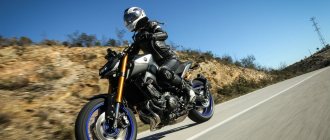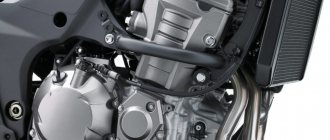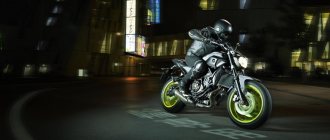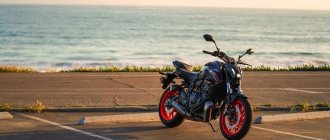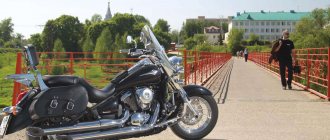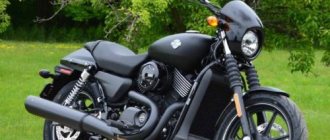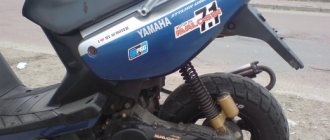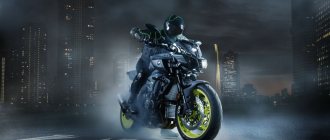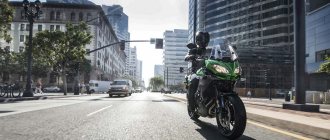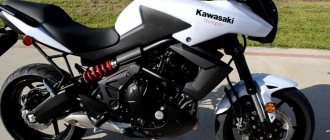Which motorcycle would you take to adventure land? Enduro, touring, or maybe sports? The choice is difficult because you don't know what lies ahead. Or maybe put it on universal machines such as Versys 1000 or Tracer 900?
Kawasaki VS Yamaha
What is an adventure? Looking for a definition, I found, in particular, the following statement: “it is a situation in which you would not necessarily like to find yourself, but which you experience.” Does this mean you can't plan adventures? Following this line of reasoning, riding through the land of adventure on a motorcycle is heading towards a place full of surprises for which you are not at all prepared. And this, in turn, means that in order for the adventure to be enjoyable, you must be prepared for it to the maximum extent possible. This leads to the idea of utility motorcycles, and the Kawasaki Versys 1000 and Yamaha Tracer 900 certainly are.
Manufacturers classify both motorcycles as touring motorcycles (Versys describes it as an adventure tourer, and Yamaha describes its Tracer as a sport tourer), but the scope of their capabilities goes beyond these concepts. These machines will perform in any conditions as long as you don't push them to extremes. You can ride them through gravel, but heavy terrain is too much for them. You can drive faster, but it's not exactly sporty. In the saddle you can cover several hundred kilometers a day, but even here it is closer to light tourism than to survival.
Kawasaki Versys 1000 Tourer. This bike is undoubtedly big. It's larger than the Tracer and has more space. This is a higher class, and it is also more expensive.
The tachometer dominates the cabin. The right display provides a lot of information, including gas mileage.
The front fairing, when viewed from this side, looks like the head of a monstrous insect from a sci-fi horror film.
The durable hand covers suggest the adventure nature of the bike and also keep water off your hands when it rains.
International moto
Yamaha and Kawa are free from any ideology. By day, you won't find smarter motorcycles in this class. They are driven by engines with the correct power ratings: 115 hp. (Tracer) and 120 hp (Versys) , and the three-cylinder Yamaha is absolutely stunning: it responds very willingly to the throttle, spins into corners briskly and produces a sound that gives goosebumps.
The Kawasaki's inline-four is more powerful and more refined, even when it vibrates slightly when twisted into corners. However, it looks a little colorless. Moreover, in the upper rev range it seems as if someone is grabbing it by the throat: it only revs up to 9700 rpm. The Yamaha is more energetic in this regard and, at least until fourth gear, it revs vigorously to 11,200 rpm. In fifth and sixth gear, the speedometer stops at a speed of 210 km/h. This is an electronic lock. The Kawasaki accelerates to 225 km/h. However, for daily driving this does not play a major role.
More interesting is the fact that both cars consume 4.4 liters of gasoline per 100 km, which is not that much. Thanks to its large fuel tank, the Versys has a theoretical range of 70 km, although the Tracer's range of over 400 km is also impressive.
A horse and a place in the government to the one who can overcome this distance in one go. The Tracer is not the most comfortable, and the hard sofa, which can be installed at one of two heights (850 and 860 mm), deserves a three-letter rating.
Yamaha MT-09 Tracer. It has a slender silhouette and a “wasp waist”, but there is also enough space for a passenger. However, it is a slightly lower class of motorcycle than the Versys.
The angular control panel exudes sadness. The depressing gray color makes up for the wealth of information.
The headlights have something of a cat's eye look to them. It is, in particular, thanks to them that the front of the motorcycle looks light and thin, but at the same time passionate.
Yamaha MT-09 (FZ-09) / Tracer 900 motorcycle review
Motorcycle with electronic throttle. 3 modes: A, STD, B. I rode mainly on STD. I read in the MOTO magazine that the STD mode is comparable to A in terms of the sharpness of the response to the throttle. To be honest, I didn’t give a damn to the motorcycle; little experience, running-in, getting used to each other. I accelerated to 170, then it was cold (late winter) and scary)
Of the minuses:
— Quite seriously it throws dirt at the lower central part of the radiator. Visually, the lower edge of the front wheel fender is lower than the radiator, but dirt still heavily clogs the radiator. By the end of the ride, the radiator is filled up to halfway in the center. You'll have to look for some kind of visor for the lower edge of the radiator, or get something yourself.
— Electronic throttle. I consider it more of a minus than a plus. The motorcycle does not have stabilization systems, but there are 3 throttle operation maps: A, STD, B. A - sharp and sharp response to the throttle, B - smooth response to the throttle, STD - something in between A and B (at least at least that's how it was intended). You can switch modes on the go. Every time you start the motorcycle engine, the throttle mode always goes to STD (WTF?!). Naturally, like any electronic throttle, there is a time lag between the movement of the throttle stick and the actual opening of the throttle. In mode B, this lag is practically not felt, but in STD mode it is felt... Very much felt. Personally, I didn’t really notice the difference between modes A and STD. Although, this is most likely because I drove in mode A a couple of times towards the end of last season.
In general, I personally don’t like the general transition to electronic gases in both cars and motorcycles. Since this model doesn't have stabilization, I would prefer to have fly-by-wire throttle control.
— The head light will probably have to be improved. Personally, low beam is not enough for me, especially on the highway.
Otherwise, I'm happy with everything so far.
Consumption - 6-6.5 liters. Naturally, I don’t drive 60 kilometers per hour. The route is 160-180 km/h (another 400 km of running time). The city - from every intersection to a point (with your head, of course). The engine is torque. It starts easily with a simple smooth release of the clutch handle. From 30 km per hour it accelerates very briskly in third.
The tidy is completely electronic. Excellent readability both at night and during the day. The control panels are convenient. Everything is clearly visible in the mirror (my height is 174). I can easily reach the asphalt with my feet.
Yamaha MT-09
In general, the choice was either to wait for 07 or take MT-09, which were in stock. Only 115 hp was scary. and reviews on the English-language Internet that this is a very angry and aggressive motorcycle for advanced riders. Friends (liter specialists) advised taking the MT-09 “with a reserve”, because in their opinion, not even a season will pass before the MT-07 turns out to be small... Friends and a sales person from the Yamaha showroom persuaded me. I decided to take MT09. Moreover, the difference in price is only 25 thousand.
The motorcycle was delivered within a week from the Yamaha warehouse in Russia. Race Blue color.
First impressions (I've already driven 600km).
+ Instant acceleration. The engine still runs no higher than 6000, but even up to 6000 is enough not to think about power.
+ Comfortable fit
+ Very good and confident brakes
+ Comfortable steering wheel
+ At first the location of the display seemed “controversial,” but after 100 km I want to say that it’s even convenient.
+ very clear box
+ comfortable suspension, both front and rear. Sometimes I even think about “twisting” her
+ very easy to manage. With balance in a traffic jam you can ride like a bicycle
+ everyone pays attention
— The howl of the box on N. or is it a feature or a run-in - I don’t know. But the howl is strong. I'll find out during the first maintenance.
— Howl of third gear. But over time he became quieter.
- The seat is uncomfortable. It's hard to sit for more than an hour. You need to buy another one, which costs around 12,000 rubles.
— It’s impossible to go more than 120 on the highway on a naked bike. Optional glass required
— Every time the motorcycle starts, the engine operates in Standard mode, which is quite jerky. Mode B is suitable for the city, with smooth engine operation.
— The tank size is too small. I don’t know what the consumption is, but I refueled every 140-160 km.
Well, the general feeling is that it’s an excellent motorcycle, so far I haven’t regretted at all that I chose 09 instead of 07.
The MT-09 has a tank of 14 liters, I fill it with 98-5 (Lukoil). The instructions say that 95Premium is also possible. The daily driving style is normal with small elements of “sinfulness”. those. If possible, I can drive within 90 in the city and start without fanaticism from traffic lights. But without completely unscrewing the throttle, as in sports. Moderately.
in the city the computer shows consumption of 6-7 liters per 100 km, which in reality translates into 150-180 km from full to empty tank.
outside the city, the driving style is within a comfortable range of 140-160, but taking into account frequent speed reductions and reverse accelerations. The computer shows 7-8 liters, in reality the tank is enough for 140 km on the highway. If you twist it, you can drive a full tank for 100 km.
If you drive like a pensioner, the computer shows 4-5 liters. But who drives an MT-09 like that?
Kawasaki and chair
On the other hand, on the Kawasaki, the entire crew sits freely and comfortably, almost like in a chair. Unlike the Yamaha, you sit on the bike rather than on it, and you're much better protected from gusts than on the Yamaha. The Kawasaki's fairing is simply larger, although it should be added that the interior finish doesn't look very good. In both motorcycles, the window height is adjusted manually, without tools. After changing the height of the windshield, the noise behind it changes: the Yamaha seems very loud with the windshield up, while the Kawasaki is a little quieter.
Before you go on a trip, you must pack your things. And in this regard, the Versys 1000 Tourer performs better. Two plastic chests with a capacity of 28 liters each, along with a durable trunk, provide so much space that you won't think twice about whether you really need to take this T-shirt. Yamaha responds to this with two hard bags or soft boxes - whichever you prefer. Their total capacity is about 42 liters.
Aka FJ-09, aka Tracer 900, aka simply Tracer.
Crossovers.
The consumer is spoiled! I remember my first motorcycle - a Sibikha Fora with 400 cc, produced in 1992. Like first love - the best motorcycle in the world! It cornered perfectly, was extremely comfortable on a long journey, and was amazing at traffic lights with its dynamics. And how with delight I told my friend about the incredible 180 km/h achieved on... of course a closed track, accompanied by an instructor, ambulance, fire brigade and rescue boat. However, time passes, we change our two-wheeled friends, gain experience and begin to look at technology more critically. You can't please us these days. Road worker? Archaic! Sport? For the psychos! Turynda? Fat! We constantly hear something like - I want an inexpensive motorbike for the track, but so that it’s ok in the city, and sometimes to the countryside 10 km on a dirt road and so that my friend can feel comfortable on the back and the fork must be reversed, and the engine is diesel, like on mine Opel... in general, I still want to drive in the back, like those blacks in shorts from YouTube! It’s exaggerated, but there is a request for a motorcycle for everything. To our joy, the damned capitalists are closely monitoring our wishes. For example, motorcycles that are called crossovers (or all-rounders, not in our country). The approach is the same as with cars. A passenger car chassis, a higher seating position, a hint of off-road capability and all sorts of features on the topic of practicality. I think the best example is the Honda nc700/750. Simple chassis, comfortable upright position, compact/elastic/economical motor and relatively low price. More or less suitable motorcycles include the 650 Kawasaki Versys, 800 Honda Crossrunner, Yamaha Tracer and the excellent S1000XR. They don’t shine in any discipline, but almost everyone can do it!
Choice.
After selling the Siber, I wanted a fresher litrosport, but... a crisis happened and I realized that I actually wanted something more affordable and, if possible, as fresh as possible. The classic Yamaha MT-09 seemed like such a motorcycle to me. Relatively inexpensive, excellent engine and light weight. Everything suits us - shall we take it? In fact, no . Surely you have experienced a similar feeling - you have decided on the key parameters, price, color, you are already figuring out what is missing in stock... and the worm of doubt continues to gnaw.
The classic Yamaha MT-09 seemed like such a motorcycle to me. Relatively inexpensive, excellent engine and light weight. Everything suits us - shall we take it? In fact, no . Surely you have experienced a similar feeling - you have decided on the key parameters, price, color, you are already figuring out what is missing in stock... and the worm of doubt continues to gnaw. What did MTkha not please? The main thing is that after sports I will miss wind protection. Wind deflectors on classics are attached to the motorcycle in such a way that they transfer air flow pressure to the steering wheel, and this is bad for me personally. The expressionless face is fixable, but I don’t like the collective farm. Yes, after all, I already had a classic! That. The next candidate for my new motorcycle was the Tracer, which is still the same MT-09, but: Wind protection - check. Expressive muzzle - check. Something new is also a check. Of course, it is a little heavier (not fatal), the steering wheel is wider, more expensive, and in general I have a rule - not to look at new equipment that has not been sold for at least a year, which means the manufacturer has not yet managed to overcome all childhood diseases. On the other hand, the regular MT-09 is already on sale and... you only live once.
What did MTkha not please? The main thing is that after sports I will miss wind protection. Wind deflectors on classics are attached to the motorcycle in such a way that they transfer air flow pressure to the steering wheel, and this is bad for me personally. The expressionless face is fixable, but I don’t like the collective farm. Yes, after all, I already had a classic! That. The next candidate for my new motorcycle was the Tracer, which is still the same MT-09, but: Wind protection - check. Expressive muzzle - check. Something new is also a check. Of course, it is a little heavier (not fatal), the steering wheel is wider, more expensive, and in general I have a rule - not to look at new equipment that has not been sold for at least a year, which means the manufacturer has not yet managed to overcome all childhood diseases. On the other hand, the regular MT-09 is already on sale and... you only live once.
About the advantages of a motorcycle.
I won’t ramble on with thoughts and will briefly go over the pros and cons. 1. Motorrrrr. Very funny. 850 cc, 115 horsepower + 88 Nm of torque + weight of 210 kg + top speed of 230 km/h = at medium speeds you can provide yourself with a good acceleration kick at any time. 2. The tank is 18 liters - a little more than a simple MT. It's a small thing, but nice. 3. Large, convenient tidy with useful and not so useful features. For example, the “ECO” indicator - save gasoline, take care of nature, keep the speed lower, switch to higher speed early - well, yes, yes. 4. Unlike the regular MT-09, there are more comfortable seats + 2 driver positions at a height of 845 or 860 mm. 5. LED headlight with an unnatural bluish color, which is easily noticeable by car drivers. Plus 2 dials for headlight height adjustment. 6. Height adjustment of the windshield. 7. ABS + switchable traction. 8. Wide, comfortable steering wheel. 9. Operating modes. Standard, A (awesome), B (boring). The latter is suitable for running in and rain. 10. Cigarette lighter. 11. Central stand. 12. Convenient remote controls with large buttons from Pimp. 13. Clear box with feedback. Not a Honda, of course, but definitely better than a Suzuki or a Kawasachi (guys, this is strictly IMHO). 14. I liked the brakes - informative and with good force, definitely better than on jixers before 2009 15. The stock version does not make you despondent, like on a Siberian, for example. It felt like you were riding an electric bike. 16. Hand protection only slightly diverts the air flow, so in hot weather leather gloves are quite ok.
1. Motorrrrr. Very funny. 850 cc, 115 horsepower + 88 Nm of torque + weight of 210 kg + top speed of 230 km/h = at medium speeds you can provide yourself with a good acceleration kick at any time. 2. The tank is 18 liters - a little more than a simple MT. It's a small thing, but nice. 3. Large, convenient tidy with useful and not so useful features. For example, the “ECO” indicator - save gasoline, take care of nature, keep the speed lower, switch to higher speed early - well, yes, yes. 4. Unlike the regular MT-09, there are more comfortable seats + 2 driver positions at a height of 845 or 860 mm. 5. LED headlight with an unnatural bluish color, which is easily noticeable by car drivers. Plus 2 dials for headlight height adjustment. 6. Height adjustment of the windshield. 7. ABS + switchable traction. 8. Wide, comfortable steering wheel. 9. Operating modes. Standard, A (awesome), B (boring). The latter is suitable for running in and rain. 10. Cigarette lighter. 11. Central stand. 12. Convenient remote controls with large buttons from Pimp. 13. Clear box with feedback. Not a Honda, of course, but definitely better than a Suzuki or a Kawasachi (guys, this is strictly IMHO). 14. I liked the brakes - informative and with good force, definitely better than on jixers before 2009 15. The stock version does not make you despondent, like on a Siberian, for example. It felt like you were riding an electric bike. 16. Hand protection only slightly diverts the air flow, so in hot weather leather gloves are quite ok.
Minuses.
1. Steering wheel. Wide also due to the hand protection, which is more a part of the design than protection. It’s sad in the aisle after a sport where you just ride and don’t worry. Then you fold the mirrors and don’t worry even more. 2. Suspension. Yes, it’s from an ordinary road builder, albeit retuned, but of course I want it to be like a Siberian, or better yet, like a Beha, and for the same money... hmm. Subjective moment. Maybe sports is not enough for me, because everyone has their own riding style and needs. 3. Wind protection. Yes, it is here and works, but with a stock windshield after 130, a ragged stream of air flies into your helmet, which creates both noise and vibration. I got myself a big mug from Givi. Again the point is subjective. 4. Wind protection again. More precisely, the mechanism for adjusting the windshield. It was clearly invented by a person who has no idea about motorcycles. 2 vibration adjustment knobs spontaneously unscrew, and the other day 1 of them decided to leave the side along with the plastic retainer. Moreover, the problem is solved with a penny washer, which removes a significant part of the vibrations from the clamp and bolt. Big hello to Yamaha. 5. Seat. It is certainly more comfortable than on the MT, but for a long journey I would like something softer. Subjective of course.
A couple of interesting features. Due to the short wheelbase and direct landing from traffic lights in the first two gears, the traction wheel constantly catches attempts to get into reverse and chokes the engine in the first two gears, so if you want to show someone Kuzka’s mother, we turn off the traction, move as close as possible to the tank and lean forward. It turns out to be a kind of cross version. Again, you need to be prepared that the unloaded front wheel will start to “sausage” at the very first hole, but the effect is quite controllable. For example:
What's the result?
I tried driving at different paces, through traffic jams in the city and on the highway. I'm happy with the technology. I caught myself thinking that, by and large, this is a motorcycle for the widest audience. For beginners and for guys with experience. For long journeys and for the city. For those who like to shoot and drive slowly. For boys and girls, moms and dads If by analogy with cars, it’s probably like a German SUV with a diesel engine, but definitely not a boring utilitarian Japanese, which the nc750 is more like.
I'm happy with the technology. I caught myself thinking that, by and large, this is a motorcycle for the widest audience. For beginners and for guys with experience. For long journeys and for the city. For those who like to shoot and drive slowly. For boys and girls, moms and dads If by analogy with cars, it’s probably like a German SUV with a diesel engine, but definitely not a boring utilitarian Japanese, which the nc750 is more like. If you ask yourself the question of what to replace it with, then the competitors are who are heavier, who are more vegetable. Here's the S1000XR, yeah, but it stands like a cast-iron bridge. You can buy a second bike, sport for the track or endura, you know what it’s for. The motorcycle allows you to ride according to your mood. You can be quick, take turns, and you can hustle kilometers along the highway. Of course, in the first case you will be more pleased with the R6, and in the second with a pimp, but I can only afford 1 motorcycle
If you ask yourself the question of what to replace it with, then the competitors are who are heavier, who are more vegetable. Here's the S1000XR, yeah, but it stands like a cast-iron bridge. You can buy a second bike, sport for the track or endura, you know what it’s for. The motorcycle allows you to ride according to your mood. You can be quick, take turns, and you can hustle kilometers along the highway. Of course, in the first case you will be more pleased with the R6, and in the second with a pimp, but I can only afford 1 motorcycle
The path is winding
The road leading into the unknown cannot be simple, that’s clear. In a series of turns, the first of the two to show itself was the Tracer, which has a Dunlopy D 222 L. The bike moves quickly and moves easily, only a clearly visible straightening moment during braking in the assembly slightly spoils the good mood. The radial clamps work efficiently and effectively, providing a clear actuation point, and the handle is adjustable. The fork and shock tuning are firm but not uncomfortable.
Both Kawasaki and Yamaha are universal motorcycles in their purest form.
After switching to a Kawasaki running Bridgestone T 30 F tires, the Tracer rides well, but the Versys are even better! Turns of any radius can be overcome more comfortably and without straightening torque. The fork is more comfortable, but the price for this is weak feedback from the front wheel. The brake seems to be a little dull. Compensating for this is precision ABS. Additionally, its four-cylinder engine has stronger mid-range acceleration.
Post Views: 2,347
